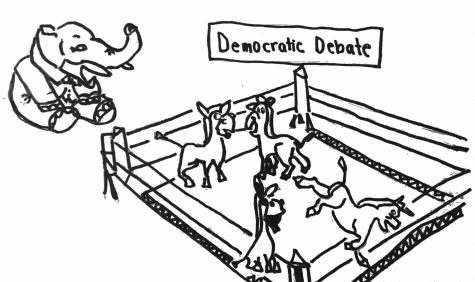Choice overload in the Democratic primaries
September 22, 2019
After nearly three long years of outrageous headlines and human rights infringements, President Donald Trump’s first term is finally coming to a close. As the 2020 election rapidly approaches, many Americans look towards a brighter future, one with a Democratic president.
Unfortunately, until then, voters have to weed through an excess of Democratic candidates in various shades of forgettable.
As of now, there are 20 presidential candidates for the Democratic party running against only three Republican candidates; a huge increase from the five major Democratic candidates of the 2016 election. Although it might seem beneficial to have a plethora of candidates to choose from, an overabundance of choices can result in an effect known as “choice overload,” in which too many options can negatively affect the brain’s ability to decide.
In a study conducted in 2000 by Professors Sheena Iyengar and Mark Lepper from Columbia and Stanford University, consumers were subjected to two tables of jam, one with six options and one with 24. Their study found that customers were ten times more likely to buy jam from the table with six choices.
Similar to the jam experiment, when voters are faced with a superfluity of Democrats to choose from, they are less likely to make a final decision.
Not only does having a profusion of candidates hurt voter participation, but it also makes it harder for complete media coverage, meaning the public remains more ill-informed than they would be with fewer candidates. The AP-NORC ran a poll in June, just before the first debate, and found that only 22 percent of registered voters who identify as Democrat claimed to know a lot about the perspectives of Democratic candidates on certain issues, with 62 percent knowing a little and 15 percent knowing nothing. There are too many Democratic candidates to grant each one adequate media coverage, which makes it more difficult for the public to make informed voting decisions.

Of the 20 candidates qualified for the third Democratic debate, only eight of them are polling above one percent. If those 12 polling at or below one percent dropped out and focused instead on running for the Senate, it would be easier for voters and the media to focus on the candidates with a real shot at winning the primaries. It would likely also lead to more Democrats in the Senate.
Having a more Democratic Senate could be as impactful as having a Democrat in the White House. A Democratic president can have a harder time getting things done if the Senate still has a Republican majority, as was seen in the Senate’s obstruction and pushback during the Obama presidency. Many candidates struggling to be seen in the primaries would have a much easier time running for seats in the Senate.
Although it is true that even candidates polling badly deserve a platform for their opinions, giving everyone a voice takes away the opportunity for voters to hear the perspectives of the candidates who will be in the race when it really matters. When 20 voices are given the spotlight, the loudest and most outrageous sound bites get popularized instead of genuine ideas from realistic candidates, which could lead to the radicalization of the party.
In the 2016 election, 17 Republican candidates went into Iowa caucuses, which arguably helped win Trump the election. His opinion was the loudest and most different from his fellow candidates, even though he had little political or military experience. Without narrowing down the field early on, the Democrats risk repeating the dynamic of 2016, allowing extreme, contrarian candidates like Trump to rise to the top.
A survey administered by Monmouth University in 2019 found that 57 percent of registered voters think it is time for a new president. But that change cannot happen until the Democratic Party is united under a few strong candidates, rather than split across an endless sea of weak ones.























